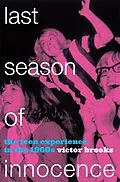Last Season of Innocence discusses the lives of the preteens and teenagers who were in junior high school, high school, and the first year of college in the 1960s. These are the young people who read Seventeen and Mad, watched more television than their older siblings, and tended to listen to 45 rpm singles or "mono" LPs rather than the more sophisticated stereo albums of their older siblings. Substantial numbers of these teens could and did join political protests, but they also engaged in a more personal daily struggle with school dress codes and parental intrusion on social life. In a nation where a third of the population was under nineteen, they were hardly invisible, but their experience seems to have been marginalized by the twenty-somethings who largely redefined the meaning of the youth culture and took center stage in doing so. Brooks offers a unique account of the much-chronicled 1960s by examining the experiences of these preteens and teenagers.
Autorentext
Victor Brooks is professor of history and education at Villanova University. He is the author of ten books, including Boomers: The Cold-War Generation Grows Up; The Fredericksburg Campaign, nominated for the Virginia Literary Prize; and Hell Is Upon Us: D-Day in the Pacific, a feature selection of the History Book Club.
Zusammenfassung
Last Season of Innocence discusses the lives of the preteens and teenagers who were in junior high school, high school, and the first year of college in the 1960s. These are the young people who read Seventeen and Mad, watched more television than their older siblings, and tended to listen to 45 rpm singles or "mono" LPs rather than the more sophisticated stereo albums of their older siblings. Substantial numbers of these teens could and did join political protests, but they also engaged in a more personal daily struggle with school dress codes and parental intrusion on social life. In a nation where a third of the population was under nineteen, they were hardly invisible, but their experience seems to have been marginalized by the twenty-somethings who largely redefined the meaning of the youth culture and took center stage in doing so. Brooks offers a unique account of the much-chronicled 1960s by examining the experiences of these preteens and teenagers.
Inhalt
Introduction
Chapter 1: Teen Life in 1959: The Gateway to the Sixties
Chapter 2: Teen Family Life and Social Life
Chapter 3: High School, USA
Chapter 4: Teen Beat: The Twist to the Beatles
Chapter 5: Teens on Screen
Chapter 6: Teens in Transition: Home Room to Dorm Room
Chapter 7: Teen Consumers and Adolescent Ambassadors
Chapter 8: Coping with the Generation Gap
Chapter 9: The Teen Music Explosion, 1964-1969: Myth and Reality
Chapter 10: Teens at War
Chapter 11: Visualizing Teens, 1964-1969
Chapter 12: Yesterday Once Again: The Sixties Teen Experience as History
Conclusion
